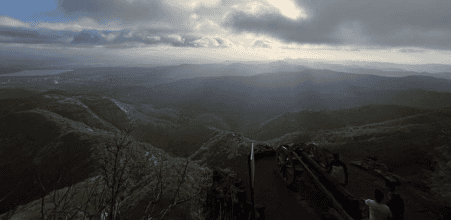“Gad ala, pan Sinha gela” – “The Sinhagarh Fort is conquered, but the Lion was lost”. It was a remorseful exclamation of Shivaji when he came to know that Tanaji Malusare won the Sinhagarh Fort but lost his life.

Sinhagarh Fort is a 14th-century fort situated 1300 m above mean Sea Level in the Western Ghat mountain range in Maharashtra.
It is one of the best-preserved forts showcasing Maratha Power that emerged under the leadership of Chhatrapati Shivaji Maharaj during the 17th Century.
The original name of this fort was Kondhana. But it is best known by the name of Sinhagarh owing to the difficult terrain where it is situated which makes it extremely difficult to conquer.
Since I am here in Pune for my four-week training at the Films and Television Institute of India (FTII). I wanted to get a glimpse of this magnificent fort that has stood the test of time. In childhood, I read the story of Tanaji Malusare who scaled the nearly impossible walls of this fort in the dead of night and defeated the Mughal commander to fulfil his vow.
Fort Sinhagad, as it is also referred to, is 28 km from Pune City. Fort can be reached using public as well as private transport. But I booked Uber Rental to cut inconveniences. The Fort opens at 6 in the morning. Monsoon season is the best time to visit the fort.
I along with my colleagues at Indian Information Service (IIS) started our journey early morning. It was mesmerizing to see the sun slowly climbing above the hills on our way to the fort. Thanks to cyclone Biparjoy, the Fort was shrouded in dense fog when we reached there. Gusts of winds were making us shiver with cold.
Sinhagarh Fort is situated atop a hill giving an unrestricted view of the surroundings. Our Driver told us that on clear days one can see 7 nearby forts from the parapet of this fort. We started our trek from the car parking. Stairs cut in basaltic lava rocks were leading to the fort. We were among the first tourists to enter the fort. A huge entrance having wooden doors was the first attraction. The gate was well fortified to repel any enemy advancement. It had vertical slits from where soldiers could fire arrows at the attacking armies.

Past the gate, there were two ways. One was directly going into the interior of the fort and the other was towards Topkhana. We choose Topkhana. Topkhana used to store artillery and shells. An Artillery was mounted at the wall facing the Pune city. Perhaps it was installed to provide firepower to defending forces. Bypassing the easy route, we took treacherous stairs to climb our way to the fort’s interior. It was a scary climb on loose rocks. The Interior of the Fort was full of greenery. Trees of Mango, Guava, Neem, banana etc. were lined across pathways.
We were hungry after an hour-long trek. We stopped at a dhaba to grab quick breakfasts and tea. Villagers from nearby have permission to run a dhaba inside the fort to cater for the needs of the tourists. Tilak Niwas was situated very close to our dhaba. Bal Gangadhar Tilak use to visit this lodge as a summer retreat. Gandhi Ji met Tilak here after his return from South Africa.

After a quick breakfast, we proceeded to Samadhi Sthal of Tanaji Malusare. It is the place where Tanhaji laid his life in the conquest of this formidable fort. A bust of Tanaji has been installed here. Life-size statues showing Maratha soldiers in action have also been put on public display. A wall has also been erected, depicting the oath that Tanaji took to conquer this fort in front of Shivaji and his mother Jeeja Bhai.
Kondheswar Mahadev was our next stoppage. It is an old temple dedicated to Lord Shiva. He is considered as the protector of the fort. The Temple gate was locked, but we could see inside the temple through a perforated gate and the Nandi statue sitting in front of the temple. A huge communication Tower stood tall next to the temple. It is used for broadcasting TV signals.
Next, we saw the resting place of Raja Ram, the eldest son of Shivaji. It was situated off the main trek. A Tomb has been erected in his honour.

Wind Point was our next stoppage. It is the northernmost point of the fort. Being a vantage point surrounding a large valley, it is excessively windy. We had lemon soda as Tea was off the menu in such windy condition. We continued our trek around the ramparts of the fort. The Fort walls have been constructed at a near-vertical slope that makes climbing virtually impossible. There were numerous water ponds in the fort. These ponds were used to harvest water during rainy reason and could be later used for drinking purposes.

By the time we decided to return, the fort was full of tourists. Sinhagarh Fort is a popular destination among Pune citizens for the weekend. Most were mostly composed of teenagers who were trekking, clicking photos or resting at dhabas enjoying Maggie. A few of the tourists were also enjoying Horse riding. An elderly man was selling Unripe Mango, Guava and Blueberries nearby. We could not resist tasting them. The Mango with red chilly power was heavenly and delicious.

We spent around 3 hours at the Fort – exploring, trekking, clicking photos, and having Maggie and Tea. It was a soothing experience. Filling our hearts with a lot of pride, we came back to our hotel. The visit to Fort was worth every penny we spent on the journey.
Attribution: (Article and picture credit: Deepak Dwivedi, Assistant Director (P), Indian Information Service)
Read more: Latest



